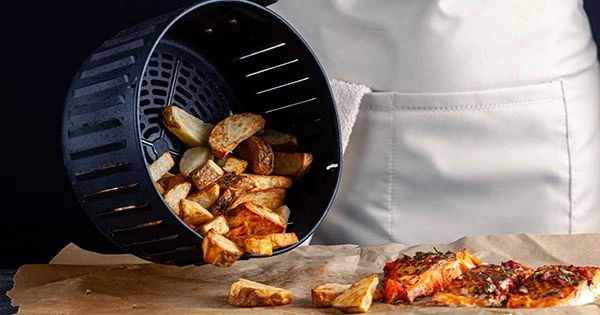The popularity of air fryers in the 2020s can be attributed to their ability to provide home cooks with a quick, simple, allegedly delectable, and presumably healthful method of food preparation without the dangers of deep-fat frying.
Sales of air fryers are allegedly increasing as consumers try to reduce their energy costs this winter when costs are expected to soar in many parts of the world.
Do these plastic devices, however, live up to the hype? Yes, air frying is healthier than some other types of cooking, and it may also be more energy-efficient, according to a number of studies.
What is an air fryer’s mechanism?
An air fryer is a countertop-sized convection oven that has been turbocharged.
Contrary to its name, there is no actual frying. Using the convection mechanism, heated air is swiftly circulated around the meal in order to function. A lovely brown crisp is produced on the meal by the so-called Maillard reaction, which uses little to no oil to simulate some of the pleasant qualities of fried food.
The Maillard reaction is a chain of chemical processes that transforms reducing sugars and amino acids into flavor- and aroma-producing chemicals while also causing food to brown. It’s essentially the cause of the flavorful combination of a chargrilled burger, fried onions, and crispy french fries.
What advantages does an air fryer provide for your health?
Due to their ability to produce the Maillard reaction without using a lot of oil, air fryers are frequently regarded as a healthy form of cooking.
Because they have large levels of trans fats, which are unsaturated fats that have experienced a process called hydrogenation, deep-fried foods are particularly bad for your health. Numerous studies have demonstrated the strong association between trans fats and a higher risk of a wide range of illnesses, including heart attacks, strokes, obesity, and diabetes.
The differences between French fries prepared by air frying and deep fat frying were examined in a 2015 study. It was determined that the food cooked in the air had a “significantly decreased fat content” but kept the same moisture content and color. The air-friend product did, however, have a little tougher and dryer texture than the deep-fried product, as well as less starch gelatinization, which may have an impact on flavor.
The article came to the following conclusion: “Overall, air frying allows the creation of lower fat content products, however, these items have different sensory qualities.
Additionally, there is some evidence to suggest that air fryers may lessen the production of dangerous substances. As previously mentioned, the Maillard process is what gives food it’s crisp browning. Acrylamide can develop when starchy foods are cooked at high heat. In addition to giving food its distinctive brown color and exquisite flavor, this molecule may also be linked to cancer, according to some research.
Another 2015 study examined the effect of air-frying on the production of acrylamide in fried potatoes. Positively, it found that when compared to traditional deep-oil frying, air-frying significantly reduced the amount of acrylamide present.
Despite this, air-frying will still result in the production of acrylamide and other possibly harmful substances, unlike boiling and steaming.
Overall, the data point to air fryers as a healthier alternative to deep-fat frying. However, there hasn’t been a lot of research done to compare air fryers to other cooking methods, most notably grilling or baking.
Are air fryers cost-effective?
The purported energy efficiency of air fryers, which is good for the environment and may save energy costs, is another factor in consumers switching to them. They take less energy to heat up than a typical oven because their cooking chamber is smaller. At least, that is the concept.
Few formal scientific studies have been conducted on this, but a few curious amateurs have tried it. The BBC put this to the test by contrasting how well chicken legs of the same size cooked in an oven and an air fryer.
They discovered that it took the chicken 35 minutes to cook in the oven and 1.05-kilowatt hours of power, which at the time cost roughly 21.04 pence. The chicken was cooked in the air fryer for 20 minutes for a total electricity use of 0.43-kilowatt hours, or 8.6 pence.
According to this extremely little and hazy scientific experiment, the air frier also seems to be energy efficient.
















